#buttonhole samplers
Explore tagged Tumblr posts
Photo
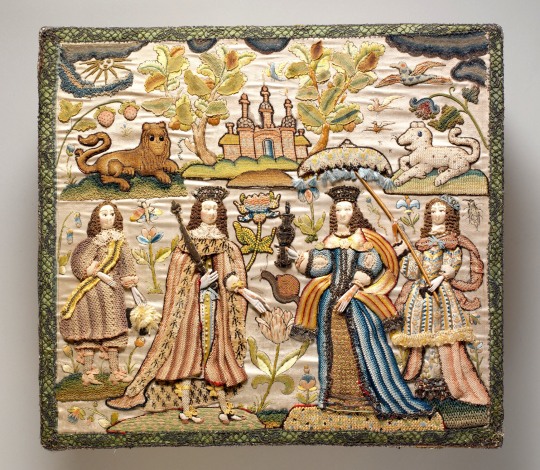
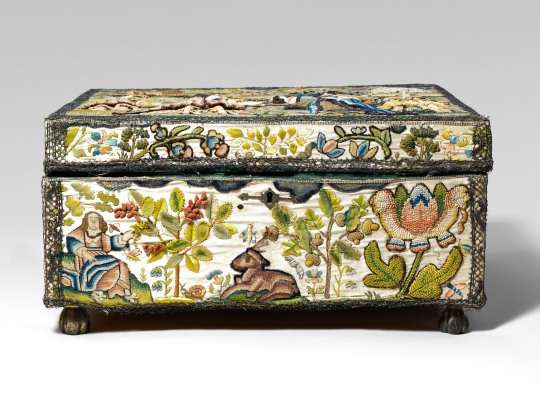

~ “This casket (an oldder English term for a box) came the Metropolitan Museum of Art with a multitude of objects indside: glass bottles (which were typically fitted into boxes of the period), a large array of sewing implements and materials - including 25 paper thread winders made from folded playing cards, bone thread winders, a bodkin, bone embroidery tools, a spool of gold filé thread (very expensive at the time), a silk tassel, several loose skeins of silk thread, a silk needle case, and a piece of detached buttonhole stitch fabric. The embroidery covering the box is a combination of surface and stumpwork (dimensional) and dates to 1670s. The completion of a decorated casket or cabinet would have been considered the culmination of a young woman’s education in needlework skills. She would have first worked on a band sampler often followed by a whitework sampler. The next step would have been an embroidered casket and sometimes a beadwork tray. The young women working on these items would have come from wealthy families as the materials used were expensive. The casket measures 20.3 × 40.6 × 36.8 cm ( 8 × 16 × 14.5 inches).” ~
13 notes
·
View notes
Photo
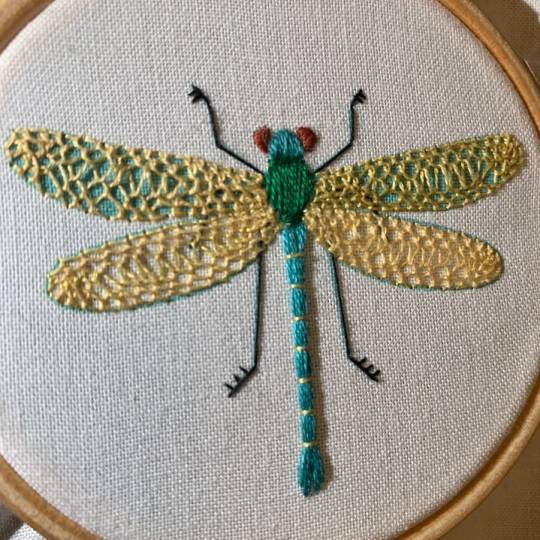
A little dragonfly from a Kiriki Press sampler. Had fun with the detached buttonhole stitch. by EssVeeSF
43 notes
·
View notes
Text
A Curriculum for Supplementary OWLs
To obtain the highest marks, students must show proficiency and general knowledge at the OWL level. Students are not expected to work perfectly at this level. For these OWLs, much of the work is done in year-long projects to allow students time to work around academic subjects.
Sewing
General
Describe process for completing a project, including:
Project organization
Obtaining measurements
Selecting a correctly sized pattern
Selecting the correct material, thread, needle (hand or machine), and notions
Pretreatment of fabric
Cutting a pattern
Marking and basting
The correct order of work for sewing a garment
Seam finishing, hemming, and sewing fastenings
By Hand
Threading a needle
Do you wax your thread
Essential stitches
Running stitch
Back stitch
Half-back-stitch
Combination stitch
Overcasting
Overhanding
Catch stitch
Blanket stitch
Hemming
Vertical hemming
French hem
Rolled hem
Rolled and gathered them
Blind stitch
Hem stitching
Buttonholes
Marking and cutting
Bound
Worked
Selecting appropriate seam
Plain
French
Felled
Basting and marking with thread
Mending
Machine
Know all parts of machine
Demonstrate machine care, e.g. oiling properly, changing the belt
Select correct needle for machine and install
Select correct thread for machine and thread properly, including bobbin
Demonstrate magical and manual treadling
Sew straight and curved seams
Projects
Project work is dependent upon your chosen era for dress. All OWL projects are expected to be sewn plain, with no embellishment. Projects are worked on through the year and submitted as a portfolio.
Optional projects may be submitted for extra credit.
Compulsory Projects
Six hemstitched linen napkins
Six handkerchiefs, your choice of fabric, must have a rolled hem
A work or night cap
One shift, shirt, or slip
An apron
Optional projects
A petticoat
A chemisette, fichu, or other such garment
A nightgown or shirt or simple pyjamas
A pair of drawers
An undervest or camisole
Needlework
To achieve an OWL in Needlework, students must show proficiency in three of the following:
Embroidery
Preparing for a new project
Preparing fabric for embroidery
Show proper use of a hoop
Threading a needle
Selecting appropriate materials
Color theory and selection
Project
Project work is to be completed through the OWL year and submitted as a portfolio.
One sampler showing fifteen embroidery stitches
Runic embroidery IS NOT accepted at OWL level, no matter what Professor Babbling says.
Knitting
Reading a pattern
Explain the pattern
Find the size and gauge information
Select the correct needles
Select the correct yarn
Demonstrate
One type of cast on
Knit stitch
Purl stitch
Garter stitch
One type of bind off
Crochet
Reading a pattern
Explain the pattern
Find the size and gauge information
Select the correct needles
Select the correct thread or yarn
Demonstrate
Chaining
Single crochet
Double crochet
Treble crochet
Tatting
Students may study shuttle tatting or needle tatting.
Reading a pattern
Select the correct thread for a tatting project
Explain the pattern
Demonstrate
Proper handling of a shuttle
Double stitch
Picot
Ring
Flip
Lace making
Students may select one or more forms of lacemaking for their OWL.
Bobbin
Tape
Needle
Students are only asked to demonstrate some proficiency, not show perfection. For each type of lace, a student should be able to:
Select the appropriate materials
Set up a project
Show knowledge of basic stitches and stitch combinations or create basic patterns
Needle lace, as it is an extremely difficult form to create, is given extra marks.
Project
Project work is to be completed through the OWL year and submitted as a portfolio.
Create 4 inches of a lace of your choice.
Fine Art
All Fine Art OWLs are submitted as a portfolio. Students may select what media they prefer, but must show some proficiency in at least pencil sketching and watercolor work.
Students may submit painted china or screens for extra marks.
Project work is to be completed through the OWL year.
Cookery
The Cookery OWL is for plain cookery and the essentials.
Essentials of Cookery
Terms used in cookery
Food selection
The magical range
Cooking utensils
Cooking methods
Preparing foods for cooking
Order of work
Menu planning
Plain Cookery
Students are expected to know how to prepare:
A breakfast cereal
A hot bread
A salad and dressing
Macaroni cheese
A plain biscuit or cake
Extra marks awarded to students demonstrating an understanding of:
Pastry
Yeasted breads
Custards
The proper cooking of vegetables
Etiquette
The etiquette OWL asks students to demonstrate an understanding of appropriate behavior in a variety of settings. It comprises both written and practical elements.
Part of the marks for this OWL will occur during afternoon tea. Formal afternoon attire is required.
3 notes
·
View notes
Text

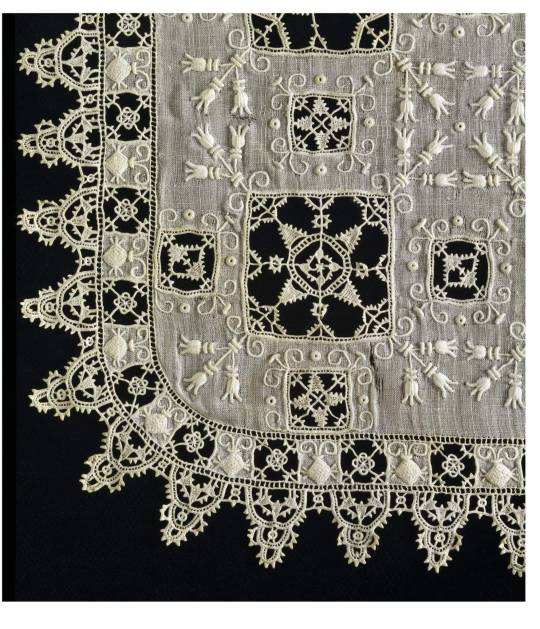
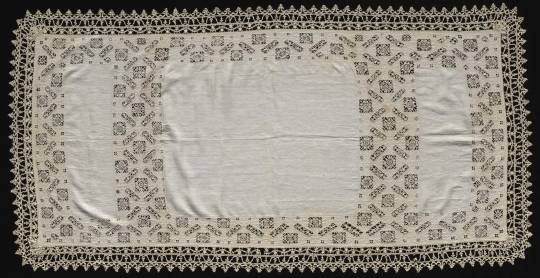
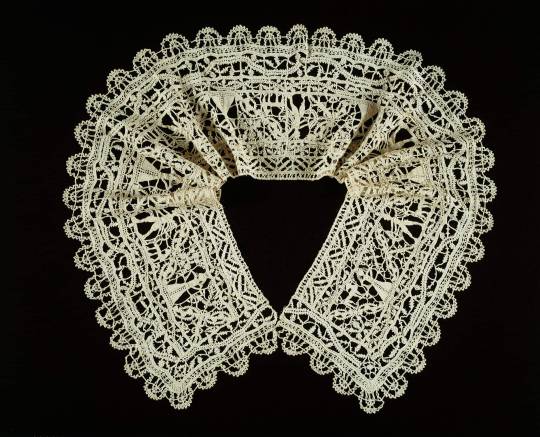




D'Artagnan.
"Having previously posted 16th century band samplers few days ago that included the essential skills of cutwork and white work; here are some examples of finished cutwork /white work showing how the same techniques were used and ultimately became the Italian needle lace known as reticella.#1 is particularly exquisite.
#1 French Linen cloth - 24 squares filet embroidery set amongst 24 squares of whitework. The cloth dates to ca.1620-30 and measures 105.3 by 137.3 cm (41.5 by 54 inches).
The cloth features darning, double running stitches, cut and drawn thread work embroidered in cross stitches, interlocking lace, overcast, and satin stitches; knots, overcast bars, buttonhole, darned, and woven wheels; needle lace filling stitches; appliquéd with plain weave and embroidered in back, bullion, cross, half cross, detached chain, double running, running, satin, single satin, surface satin, and stem stitches; buttonhole wheels, eyelet holes, and French knots; edged with bobbin straight lace.
© The Art Institute of Chicago
#2 Italian Handkerchief made in fine linen with cutwork by an unknown maker ca 1600-1640 It has whitework embroidery, worked in detached buttonhole and satin stitches, needle lace and cutwork decoration; with needle lace fillings, and whitework embroidery in detached buttonhole and satin stitches; edged with needle lace.Length: 45.5cm
Width : 45.5cm © V&A
#3 Italian linen needlepoint (Cutwork) and Bobbin Lace Cloth
16th century
Dimensions approx : 183.5 x 90.3 cm (72 1/4 x 35 9/16 in.) © Cleveland Musuem of Art
#4. Collar (Made from a Border)
Italy1575–1625
Linen, three bands of needle lace worked on a plain weave; cut and drawn work grid; edged with bobbin straight lace
Dimensions 22.1 × 150.3 cm (8 3/4 × 59 1/4 in.) © Art Institute Chicago
#5 Border from a cover, of embroidered linen with satin and stem stitches; edged with a band of bobbin lace worked with unbleached linen thread.Italian second half of 16th century
Max length laid flat length: 930mm
Max width laid flat width: 260mm © V&A
#6 as #4
#7 Alternative view of # 3
#8 alternative view #2
~~~~oooo~~~~
Cutwork describes any form of embroidery based on a woven ground from which sections have been cut away and edged. This style of whitework originated in Renaissance Italy, when nuns created fine textiles for ecclesiastical use. They first removed threads, then whole sections of background fabric to fully exploit a contrast between light and shade. This work was later contracted out to hired embroiderers, who established a tradition of decorating linens with intricate cutwork patterns. The intensive labour involved in this form of whitework made it an easy means of signalling wealth and social rank in Europe in the 16th and 17th century. Thus it became associated with royalty and the nobility, and pieces were often exchanged as high-status gifts.
Cutwork is also the origin of reticella lace; as over time embroiderers made larger and larger holes, creating 'reticella' (floating shapes) in which the linen backing fabric was almost entirely cut away, becoming known as as 'needle lace’.
~~~ooo~~~
Handkerchiefs in the 16th and 17cent made of plain linen served exactly the same function as today.
However, if they were decorated they would be carried purely as fashionable accessories and given as gifts.
During courtship, a couple would exchange symbolic gifts such as gloves, ribbons, rings and handkerchiefs. The acceptance of a gift indicated a binding commitment and be could used as proof of betrothal in the case of any disputes. Although a splendid handkerchief was seen as an intimate item, it could also be held in the hand as a display object and indication of status. Queen Elizabeth I frequently received gifts of embroidered handkerchiefs on New Years Day.
From about 1570 to 1620 cutwork and needlelace were important decorations on fashionable dress for women and men.
Love D'Artagnan xxx".
11 notes
·
View notes
Photo




Piecework Summer 2020
If you look right in the middle of the cover of this issue, you will see in white, an itty bitty crocheted piece of lace. And if you have ever been in an antique store, you have seen tons of amazing itty bitty pieces of crocheted lace made of tiny threads. I always marvel at ow they were made and wonder what possible use I could make of them as most of them are doilies and I don’t really need a doilies. So, Carolyn Wyborny took such a tiny pattern from 1931 and blew it up to a DK-weight shawl as you see in the blue. The fluted edge is very pretty and we should all keep in mind how we might adapt old patterns if we haven’t the patience for thread work.
The next images gives you some idea of the range of topics covered in Piecework. You can see antique sewing birds in the collection of Franklin Habit. They are clamped to a tabletop and then the beak opens and acts as a third hand for dressmakers by holding onto a garment edge, a braid end etc. They managed to be decorative originally, but they are also made today in a completely utilitarian form. Then you see, a creature done up in Ars Canusina embroidery from Italy and Jeanine Robertson explains the origins of the technique and the design, and then Maria Neroni and Silvana Fontanelli of the Consortium Ars Canusina offer a less whimsical geometric pattern for a table center cloth. Lastly, Olle-Petter Melin considers the different ways in which multi-color knitting has been accomplished prior to 1960 when a kind of established method set in. She has samples that show the small, but evident effect which the different methods accomplished and ponder their advantages and disadvantages. It reminded me very much of being in a millinery workshop at Judith M’s and asking Judith herself if something I was making up was ok to do--she said, “Linda, if it works, it is ok to do!” A good policy for all makers.
Lots more in this issue, an article on buttonhole samplers and your own, to make, historical lore on Native American cradleboards, on the herringbone hand stitch, on latrine hats--no I am now making that up--and more.
You can find this at your local bookstore or newsstand if they are open, or online here: https://pieceworkmagazine.com/
#piecework#piecework magazine#diy#diy projects#makers#making#carolyn wyborny#crochet#crochet patterns#crocheted shawl#sewing birds#antique sewing birds#franklin habit#arts canusina#maria neroni#silvana fontanelli#jeanine robertson#knitting#color knitting#olle-petter melin#judith m#millinery#needlework#vintage needlework#latrine hats#cradleboards#herringbone stitch#buttonhole samplers
11 notes
·
View notes
Text
Raising the Bar for Intricate Needlework
Author: Katherine Diuguid
The wealth of needlework techniques on display in 17th century English raised-work embroideries is a reminder that these pictures functioned as samplers, in which amateur embroiderers would test out different techniques as they progressed in their needlework skills.
Whether depicting Biblical or mythological characters, female figures rendered in contemporary dress often enjoyed pride of place and were worked in very intricate detail. Here, the figures may represent the five senses. Each of the female figures has been worked in long and short stitch with flat silk. Flat silk is a fine silk thread that has not been twisted or “spun” and is sometimes called filament silk. This lack of texture and shadow gives this silk thread its extremely shiny finish. Their dresses are shaded in a vertical banded fashion, which does not follow the curvature of the dress. The stripes of the petticoat and the dress of the central character have been created by couching down bands of flat silk. Each character is outlined in color-coordinated twists or tiny cording.
The leaves of the pear tree reveal my favorite 17th-century raised work detail: each detached buttonhole leaf has a shadow, which has been worked in satin stitch with flat silk behind the needle-lace leaf! The hills that the characters are standing on are also worked using silk threads in different stitches to add texture and interest to the composition.
Another way silk has been used is in the form of silk-wrapped metal purl, seen in the leaves of the trees around the castle, the leaves in the strawberries, as well as the flowers beside the leopard and above the snail. Silk-wrapped purl is a metal drawn wire coil that has been wrapped with silk. These three-dimensional purls were worked in beautiful ways to add texture and relief. In this piece, purls of various colors have been cut into small pieces and stitched down to form densely packed loops. It’s interesting to me that in all the other techniques the shading has been executed in a banded manner, but with the silk-wrapped purl the colors have been mixed together in a random fashion, or used to highlight the tips of the leaves and petals. On this similar piece in Cooper Hewitt’s collection, the silk-wrapped purl can be seen worked in loops in shaded bands on the hill in the lower right corner.
Silk-wrapped purl. Top piece shows the piece stretched out to illustrate the thread construction of the silk wrapping around the metal coil.
Katherine Diuguid is a studio artist specializing in embroidery with a special focus on metal thread embroidery. She teaches embroidery workshops nationally and internationally.
from Cooper Hewitt, Smithsonian Design Museum https://ift.tt/2s8Qq5M via IFTTT
36 notes
·
View notes
Text
Embroidery my logo orlando

Embroidery my logo orlando professional#
In the 16th century, in the reign of the Mughal Emperor Akbar, his chronicler Abu al-Fazl ibn Mubarak wrote in the famous Ain-i-Akbari: Embroidery cottage industries, some employing over 800 people, grew to supply these items. Craftsmen embroidered items with gold and silver thread. In cities such as Damascus, Cairo and Istanbul, embroidery was visible on handkerchiefs, uniforms, flags, calligraphy, shoes, robes, tunics, horse trappings, slippers, sheaths, pouches, covers, and even on leather belts. Because embroidery was a sign of high social status in Muslim societies, it became widely popular. The 17th-century Turkish traveler Evliya Çelebi called it the "craft of the two hands". Embroidered book Įmbroidery was an important art in the Medieval Islamic world. In terms of documenting the histories of marginalized groups, especially women of color both within the United States and around the world, embroidery is a means of studying the every day lives of those whose lives largely went unstudied throughout much of history. Women who were unable to access a formal education or, at times, writing implements, were often taught embroidery and utilized it as a means of documenting their lives. While historically viewed as a pastime, activity, or hobby, intended just for women, embroidery has often been used as a form of biography. Many techniques had a practical use such as Sashiko from Japan, which was used as a way to reinforce clothing. Examples include Hardanger from Norway, Merezhka from Ukraine, Mountmellick embroidery from Ireland, Nakshi kantha from Bangladesh and West Bengal, and Brazilian embroidery. Ĭonversely, embroidery is also a Folk art, using materials that were accessible to nonprofessionals. Embroidery was a skill marking a girl's path into womanhood as well as conveying rank and social standing. In 18th-century England and its colonies, samplers employing fine silks were produced by the daughters of wealthy families.
Embroidery my logo orlando professional#
This flexibility led to a variety of works, from the royal to the mundane.Įlaborately embroidered clothing, religious objects, and household items often were seen as a mark of wealth and status, as in the case of Opus Anglicanum, a technique used by professional workshops and guilds in medieval England. Historical applications and techniques Ī pair of Chinese shoes for bound 'lily' feetĭepending on time, location and materials available, embroidery could be the domain of a few experts or a widespread, popular technique. In a garment from Migration period Sweden, roughly 300–700 AD, the edges of bands of trimming are reinforced with running stitch, back stitch, stem stitch, tailor's buttonhole stitch, and Whip stitch, but it is uncertain whether this work simply reinforced the seams or should be interpreted as decorative embroidery. Works in China have been dated to the Warring States period (5th–3rd century BC). The art of embroidery has been found worldwide and several early examples have been found. On the other hand, we often find in early works a technical accomplishment and high standard of craftsmanship rarely attained in later times. there are no changes of materials or techniques which can be felt or interpreted as advances from a primitive to a later, more refined stage. It is a striking fact that in the development of embroidery. Indeed, the remarkable stability of basic embroidery stitches has been noted: The process used to tailor, patch, mend and reinforce cloth fostered the development of sewing techniques, and the decorative possibilities of sewing led to the art of embroidery. 4th century BC, Zhou tomb at Mashan, Hubei, China. Rows of even, round chain stitch used for outline and color. Detail of embroidered silk gauze ritual garment.

1 note
·
View note
Photo

Embroidered band sampler by Mary Pots, European Sculpture and Decorative Arts
Medium: Silk embroidery on linen; double running, satin, detached buttonhole, Montenegrin cross, herringbone, and chain stitches
Rogers Fund, 1913 Metropolitan Museum of Art, New York, NY
http://www.metmuseum.org/art/collection/search/219509
1 note
·
View note
Photo

Embroidered band sampler by Mary Pots by European Sculpture and Decorative Arts
Medium: Silk embroidery on linen; double running, satin, detached buttonhole, Montenegrin cross, herringbone, and chain stitches
Rogers Fund, 1913 Metropolitan Museum of Art, New York, NY
12 notes
·
View notes
Photo

Emily Bell created these needlework samplers to fulfill a homework assignment while she was a student at Bethlehem Female Seminary, circa 1830. The sampler includes examples of buttonhole, hemming, and pin-tuck stitches, measuring between 2-4 inches. #TinyTuesday
Bell, Emily. Homework Sampler. Bethlehem, Pennsylvania, Ca. 1830. Between 2-4 inches.
#BensLibrary#Samplers#Sampler#NeedleworkSampler#Sewing#1830s#BethlehemFemaleSeminary#MoravianCollege#TinyTuesday#SpecialCollections#Tumblarians#Needlework
44 notes
·
View notes
Text
TAST Catch Up 1 out of 5
Whilst rummaging through my boxes full of TAST (Take a Stitch Tuesday) embroidery samplers, I realised I had over 20 that I hadn’t shown you yet. So this is the first in a series of five posts showing everything you haven’t seen. (BTW, TAST has started afresh for 2018 so if you’d like to join in, visit the TAST FaceBook group for details).
These are in the order I embroidered them (sort of). Or…
View On WordPress
0 notes
Photo

Just Pinned to Embroideries and Cross Stitch: Sampler by T. Matus. Stitches: 1. Portuguese knotted, 2. Jordanian (combination of fern and chain), 3. Feather ,4. Twisted lattice band, 5. Fern, 6. Pekinese, 7. Vandyke, 8. German knotted buttonhole, 9. Basque knot, 10. Breton, 11. Open fishbone, 12. Chevron,13. Chevron, 14. Threaded detached chain, 15. Kerman, 16. Festoon filling, 17. Stem. http://bit.ly/2uSvxrF
0 notes
Text
Sculptural Stitching
Author: Katherine Diuguid
In celebration of the second annual New York Textile Month, members of the Textile Society of America will author Object of the Day for the month of September. A non-profit professional organization of scholars, educators, and artists in the field of textiles, TSA provides an international forum for the exchange and dissemination of information about textiles worldwide.
During the 17th century, a style of embroidery known as raised work or stumpwork became popular in England. With its interesting mixture of techniques and motifs, it served as an advanced sampler for girls, incorporating more complicated techniques and trickier materials. Usually depicting Biblical or mythological narratives with characters quirkily rendered in contemporary dress, these embroideries exude charm and whimsy, and for an embroiderer, are abundantly full of beautiful technical details!
This embroidered picture incorporates many of the lovely techniques and materials commonly seen in 17th century raised work. Techniques on display include variations of detached buttonhole, flat silk worked in various stitches, metal threads, silk-wrapped metal threads, couching using both metal threads and silk gimp, and a few found objects if you look very closely! Since I find such joy in all the various techniques blended together on 17th century raised embroidery panels, I thought I would focus here on one of my favorite techniques — detached buttonhole.
Detached buttonhole is a family of techniques where the basic buttonhole stitch is manipulated in various ways and is worked predominantly above the surface of the fabric. These manipulations allow the embroiderer to create the many different textures and patterns, including needle laces, as seen in the deer, the unicorn, the pears, and the dresses of the female characters (except the character beside the pear tree). Compare the detached buttonhole executed in a very open needle lace pattern on the gown of the small woman left of center to the tighter pattern of the right central woman’s gown. Or, by focusing just on the area of the pear tree, different manipulations of detached buttonhole can be viewed side by side. If we look at the deer and unicorn, the slightly larger scale of the stitch allows the viewer to identify the individual stitches and the rows of stitches looping into the previous row of looped stitches.
When stitching the detached buttonhole, the embroiderer has the ability to create an entire secondary surface that floats above the ground fabric. Dimensionality can be enhanced by shading forms by stitching underneath, or by padding them out. Additionally, the detached buttonhole stitch may be worked with some sides free, allowing for turned edges, or it may be stitched as fully detachable “slips” that would then have been appliquéd to the surface of the final piece. These slips were stitched to fit the pattern on another piece of fabric, detached, and then moved to this final ground fabric. By stitching the pieces down in this manner, the embroiderer could add folds and layering and create actual draping in the clothing and motifs such as the curtains and Queen’s dress in this similar embroidered picture in the Cooper Hewitt collection.
The detached buttonhole stitch allows the embroidery to lift off the ground fabric and to create texture and dimension in magical ways, especially when mixed with the metal threads. Imagine just for a moment how this panel must have shined and shimmered before the silver that is detailing the animals and characters tarnished!
Katherine Diuguid is a studio artist specializing in embroidery with a special focus on metal thread embroidery. She lectures teaches embroidery workshops nationally and internationally.
from Cooper Hewitt, Smithsonian Design Museum https://ift.tt/2CBQz6t via IFTTT
13 notes
·
View notes
Text
School Exercises
Samplers originally served as sketchbooks where women could record stitches and design ideas for future use. With the advent of printed books of patterns for lace and embroidery in the 16th century, this practice became less common, and samplers evolved into exercises for girls learning the techniques of needlework. Several samplers of nearly identical format to this one, including those of Mary Tredwell (Victoria & Albert Museum), Sarah Leesley (Museum of Fine Art, Boston) and Mary Brown in this collection, mark these samplers definitively as school exercises.
Beginning with a plain piece of fine linen, fourteen squares and fourteen circles were cut out. Some were filled with needle lace, most likely adapted from pattern books. Others are filled with hollie-point embroidery, in which tiny holes are left in densely worked buttonhole stitch, giving the appearance of patterned knitting. Hollie point was very much in fashion for ornamenting baby clothes and christening sets in the 1720s and 30s.
from Cooper Hewitt, Smithsonian Design Museum http://ift.tt/2iBdVPi via IFTTT
16 notes
·
View notes
Text
Alternating Up and Down Buttonhole Stitch Embroidery Sampler
Alternating Up and Down Buttonhole Stitch Embroidery Sampler
This is my final catch up post for the TAST embroidery challenge. Hopefully from now on I’ll be posting my samplers as I stitch them!
Stitch 71 is alternating up and down buttonhole stitch. Since I like up and down buttonhole stitch so much that I embroidered three samplers, it should come as no shock that I made two for alternating up and down buttonhole stitch. (What a mouthful! It too ages to…
View On WordPress
0 notes
Text
TAST Revisiting Blanket/Buttonhole Stitch
As well as running stitch, blanket stitch (also known as buttonhole stitch in some quarters), is another favourite stitch of mine I have chosen to revisit in my TAST embroidery journey.
I like to collect retro and vintage embroidery books, and one of my favourites is Constance Howard’s Book of Stitches. I hope to do a proper review of it at some stage, but a very basic description is “an in depth…
View On WordPress
0 notes